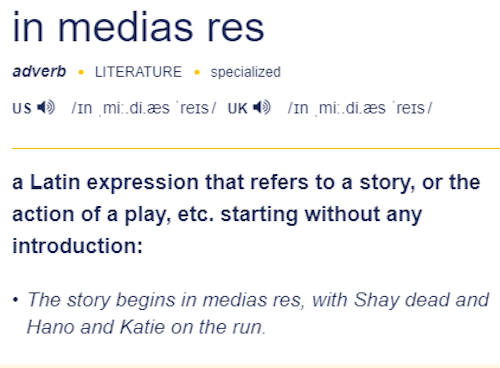When ‘In Medias Res’ Works, and When it Doesn’t

You may have heard conventional writer wisdom dissing action beginnings: car crashes, police chases – everything bad happening at the opening, right up to and including Armageddon. I’m not here to do that. I mean, think about it. Thousands of movies start that way, right? Remember though, movies are visual storytelling. They are usually faster-paced and therefore don’t have the depth books do – which is not to say I haven’t been moved by film. Hey, I watched Bambi, too!
An In Medias Res can be an arresting, in-your-face thrill ride. It can also showcase genre from page one by setting tone, pace and focus. Espionage, political thrillers, Romantic suspense, horror and mystery are examples of genres that use it effectively.
‘The boy with fair hair lowered himself down the last few feet of rock and began to pick his way toward the lagoon. Though he had taken off his school sweater and trailed it now from one hand, his grey shirt stuck to him and his hair was plastered to his forehead. All round him the long scar smashed into the jungle was a bath of heat. ‘ Lord of the Flies, William Golding
Stephen King’s, Mr. Mercedes begins with a ’97 Datsun plowing into a crowd of people.
With a few moments of thought, I’ll bet you could come up with a bunch more. But I’ll also bet that most of those examples first occur to you as the movies you’ve watched. Am I right?

There’s a reason for that.
True Story: I was writing my second book, and I slaved over the first chapter. I was proud to take it to crit group. One critter told me, ‘We don’t care.’
Ouch. But okay, I was there for feedback, and I trusted this person’s opinion, so I started over. The second pass, she still said, ‘We don’t care’.
I said, ‘WHAT?!” (yes, loud, with and exclamation point).
Then she told me something I’ve never forgotten:
‘We don’t care what happens until we care about WHO it’s happening to.’
Think of it this way. You’re stuck in traffic, crawling past an accident scene. Two cars that look like they’ve been put through a meat grinder. A paramedic crouches by a woman sitting in the driver’s seat looking dazed, ribbons of red dripping down her face.
Ugh, you think. It’ll be a long time before she gets her life on track again.
But what if, when you’re rolling by, you realize it’s your friend in that car?
Whole different reaction, right? That’s what you’re shooting for.
To me, that’s why the movie, Die Hard worked so well. Think past the bombs, aerial stunts and your dinner in your throat. Back to the beginning. It didn’t start that way, did it? It starts when Bruce Willis flies to L.A. and crashes his wife’s office Christmas party to try to get her back. And fails, miserably. She leaves him in a bathroom, broken-hearted.
THEN we get to the bang-bang, shoot-em-up for an hour. But to me, that movie is great because of that first scene. We care that Bruce is hurting, because who hasn’t been rejected in their lives? He goes on to amazingly impossible super-human stuff to save his wife, and prove to her that he still loves her.

How could you NOT want to see what happens to the poor guy?
They made us care who it happened to.
See?
Have you ever tried an In Medias Res opening? What’s your favorite movie that used one?
[…] Laura Drake focuses on when “in medias res” works and when it doesn’t. […]